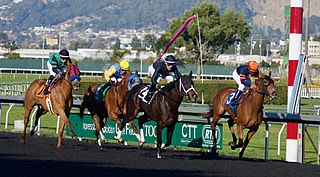
Horse racing is an equestrian performance sport, typically involving two or more horses ridden by jockeys over a set distance for competition. It is one of the most ancient of all sports, as its basic premise – to identify which of two or more horses is the fastest over a set course or distance – has been mostly unchanged since at least classical antiquity.

Flemington Racecourse is a major horse racing venue located in Melbourne, Victoria, Australia. It is most notable for hosting the Melbourne Cup, which is the world's richest handicap and the world's richest 3200-metre horse race. The racecourse is situated on low alluvial flats, next to the Maribyrnong River. The area was first used for horse racing in March 1840.

Thoroughbred horse racing is a spectator sport in Australia, and gambling on horse races is a very popular pastime with A$14.3 billion wagered in 2009/10 with bookmakers and the Totalisator Agency Board (TAB). The two forms of Thoroughbred horseracing in Australia are flat racing, and races over fences or hurdles in Victoria and South Australia. Thoroughbred racing is the third most attended spectator sport in Australia, behind Australian rules football and rugby league, with almost two million admissions to 360 registered racecourses throughout Australia in 2009/10. Horseracing commenced soon after European settlement, and is now well-appointed with automatic totalizators, starting gates and photo finish cameras on nearly all Australian racecourses.

Warwick Farm railway station is located on the Main Southern line, serving the Sydney suburb of Warwick Farm. It is served by Sydney Trains T2 Inner West & Leppington, T3 Bankstown and T5 Cumberland line services.

Warwick Farm is a suburb of Sydney, in the state of New South Wales, Australia. Warwick Farm is located 30 kilometres west of the Sydney central business district, in the local government area of the City of Liverpool and is part of the South-western Sydney region.

The Verry Elleegant Stakes, registered as the Chipping Norton Stakes is an Australian Turf Club Group 1 Thoroughbred horse race for horses three years old and older, run at weight for age, over a distance of 1600 metres at Randwick Racecourse, Sydney, Australia in February or March. Prizemoney is A$1,000,000.

Doomben Racecourse is a horse racing venue in Brisbane, Queensland, Australia. It is located in the suburb of Ascot, 7 kilometres north of the Brisbane central business district. The Doomben course neighbours another thoroughbred venue called the Eagle Farm Racecourse and can be accessed via car, train or bus. Together with Eagle Farm, these courses are considered the two major racecourses in South East Queensland, and can be seen sharing irrigation systems and some of Brisbane Racings feature events.
William Forrester was an Australian racehorse and racecourse owner.
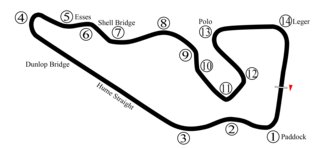
Warwick Farm Raceway was a motor racing facility which was in operation from 1960 to 1973. Warwick Farm Raceway hosted numerous major events during its life such as the Australian Grand Prix and rounds of both the Australian Touring Car Championship and the Tasman Series.

Etienne Livingston de Mestre, was a 19th-century Australian breeder and jockey of Thoroughbred racehorses. He was Australia's first outstanding racehorse trainer and racing identity. In his 30-year career, he experienced all the highs and the lows of the turf in a career which ended with him dependent on donations from racing friends.

Australian Turf Club (ATC) owns and operates thoroughbred racing, events and hospitality venues across Sydney, Australia. The ATC came into being on 7 February 2011 when the Australian Jockey Club (AJC) and the Sydney Turf Club (STC) merged. The ATC primarily operates out of their offices at Randwick Racecourse and employs approximately 270 full-time staff and over 1,000 casual staff across the five venues. The venues include Randwick, Rosehill Gardens, Canterbury Park, Warwick Farm and the Rosehill Bowling Club.
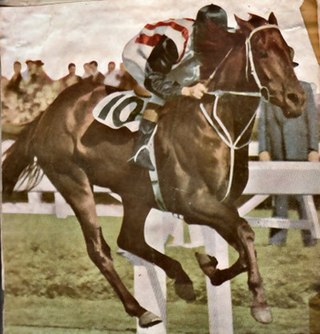
Tulloch was a champion Australian Thoroughbred racehorse who was one of the greatest Australian stayers.
The Liverpool City Cup is an Australian Turf Club Group 3 Thoroughbred quality open handicap horse race for horses aged three years old and older, run over a distance of 1300 metres at Randwick Racecourse, Sydney, Australia in late February or early March. Total prize money for the race is A$200,000.
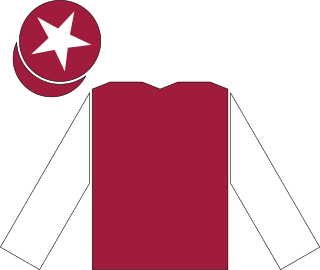
Carnegie was a British-bred, French-trained Thoroughbred racehorse and sire. Unraced as a two-year-old he won four consecutive races as a three-year-old in 1994, culminating with a win in the Prix de l'Arc de Triomphe. He remained in training as a four-year-old, winning the Grand Prix de Saint-Cloud and Prix Foy. He was then retired to stud and had some success as a sire of winners in Australia and New Zealand.
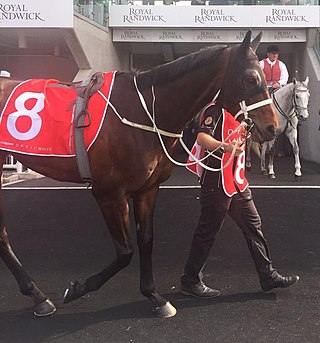
Winx is a retired champion Australian Thoroughbred racehorse. She won 37 of 43 career starts, including, between May 2015 and her retirement in April 2019, her last 33 races in succession, including 25 Group 1s, at distances ranging from 1300 metres to 2200 metres. In the World's Best Racehorse Rankings, she was the second-ranked filly or mare in 2015, improving in 2016 to become both the world's top-ranked filly or mare and the world's top-ranked turf horse. She retained this ranking in 2017 and in 2018 was co-ranked as the best horse in the world. In 2017 she was inducted into the Australian Racing Hall of Fame, only the third horse to earn this honour while still in training. Over her career, she earned more than 26 million Australian dollars.

Merman (1892–1914) was a Thoroughbred racehorse, one of the finest racehorses in Colonial Australian racing history that raced in Europe. He won at distances from 5 furlongs to 21⁄2 miles. In 2016 Merman was inducted to the Australian Racing Hall of Fame.

Carbon Copy was an Australian chestnut Thoroughbred horse, who raced from a two-year-old to a five year old recording 14 wins from 1 mile to 2 miles with regular jockey Scobie Breasley winning eight races was a member of a vintage crop of three year olds 1948–1949 including Comic Court, Foxzami, Vagabond and Bernbrook.

James Hugh Bowman is an Australian thoroughbred racing jockey. Based in Sydney, Bowman has won the New South Wales Metropolitan Jockey Premiership four times and has ridden 100 Group 1 winners. He was the jockey for Australian champion mare Winx from 2014 through to her retirement in 2019. In 2017, Bowman won the Longines World’s Best Jockey award presented by the International Federation of Horseracing Authorities. The award capped off a year in which he added to his domestic success with international Group 1 wins in Hong Kong and Japan. In 2019, he was inducted into the Australian Racing Hall of Fame, the industry’s highest accolade. Bowman is also renowned for his “She’s Apples” winning salute and his nickname of “the Undisputed Group 1 King”.
Chris Waller, is a Hall of Fame trainer in Australian Thoroughbred racing best known for training the racemare Winx, a four-time winner of Australian Horse of the Year honours.

















